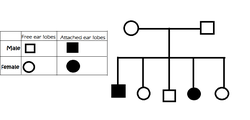Inheritance; This is interesting
 The image above represents the pedigree chart of a family with five children. It shows the inheritance of attached ear lobes as opposed to the free ones. The squares represent the male individuals and circles the female individuals.
The image above represents the pedigree chart of a family with five children. It shows the inheritance of attached ear lobes as opposed to the free ones. The squares represent the male individuals and circles the female individuals.
Which of the following conclusions drawn is correct?
This section requires Javascript.
You are seeing this because something didn't load right. We suggest you, (a) try
refreshing the page, (b) enabling javascript if it is disabled on your browser and,
finally, (c)
loading the
non-javascript version of this page
. We're sorry about the hassle.
Consider the possibility that the parents are homozygous (dominant or recessive). If E denotes the dominant trait and e , the recessive trait, then the possibilities for the children under either scheme is E E , or e e .
If the trait were y-linked, we'd expect to find that only one sex can have the trait. It is clear from inspection that members of either sex have either outcome, so this can't be true.
The last remaining choice, that the parents are heterozygous, can explain the outcome. The Punnet square for two heterozygous parents (and a non sex-linked trait) produces progeny of both phenotypes and all genotypes.